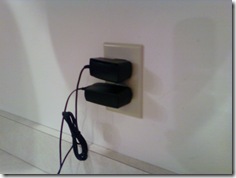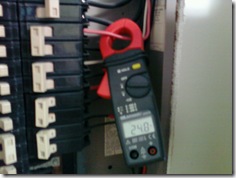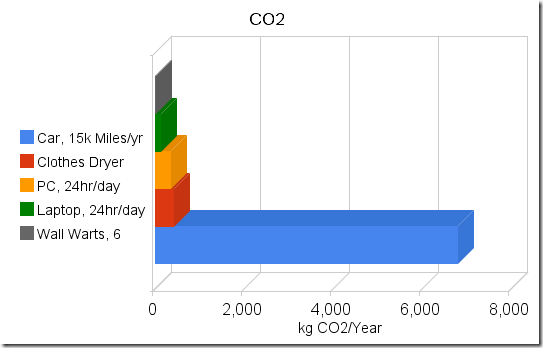
(09/29-2008 - Updated to correct minor grammatical errors. )
Let's try something unique. I’ll use actual data to see if we can save the planet by unplugging wall transformers.
Step one – Measure wall wart power utilization.
Remember that Volts x Amps = Watts, and Watts are what we care about. Your power company charges you for kilowatt-hours. (One thousand watts for one hour is a kWh).
 Start with one clamp-on AC ammeter, one line splitter with a 10x loop (the meter measures 10x actual current) and one wall wart (a standard Nokia charger for an N800).
Start with one clamp-on AC ammeter, one line splitter with a 10x loop (the meter measures 10x actual current) and one wall wart (a standard Nokia charger for an N800).And we have zero amps on the meter.
OK - That meter is made for measuring big things, so maybe I need a different meter.
Lesson one
Wall warts don't draw much current. They don't show up on the ammeters' scale even when amplified by a factor of 10.Try again - this time with an in-line multimeter with a 300mA range.

Children - don't try this at home - unless you are holding on to your kid brother and he is properly grounded to a water pipe.
(just kidding.....)
That's better. It looks like we have a couple milliamps current draw.
Try a few more. The ones I have (Motorola, Samsung, Nokia) are all pretty close to the same. Lets use a high estimate of 5mA @ 120v, or about a half of a watt.
Similarity, checking various other parasitic transformers, like notebook computer power bricks, yields currents in the low milliamp ranges. When converted to watts, the power draw for each brick is somewhere between one-half and two watts.
To make sure the numbers are rational and that I didn't make a major error somewhere, I did the simplest check of all. I placed my hand on the power bricks. When they are plugged into the wall and nothing is plugged into them, they are not warm. (Warm = watts).
One more sanity check. Plugging three notebook power supplies and three phone power supplies into a power strip shows about 30mA @ 120v for all six bricks, which is under 4 watts, or less than a watt each. My measurements are rough (I don't have a proper milliamp meter), but for estimates for a blog that nobody actually reads, they should be close enough.
So let's pretend that I want to save the planet, and that unplugging power bricks is the way I'm going to do it. I'll need to periodically plug them in to charge whatever they are supposed to charge. Let's assume they'll be plugged in for 4 hours per day and unplugged 20 hours per day. If I have a half dozen power bricks, I'll save around 5 watts x 20 hours = 100 watt-hours per day, or the amount of electricity that one bright light bulb uses in one hour. That would add up to 35kWh (Kilowatt-hours) per year. Not bad, right?
Until you put it into perspective.
Perspective
Let's take the other end of the home appliance spectrum. The clothes dryer (clothes tumbler to those on the damp side of the pond). That one is a bit harder to measure. The easiest way is to open up the circuit breaker box and locate the wires that go to the dryer.

Hooking up to the fat red wire while the dryer is running shows a draw of about 24 amps @ 220 volts. I did a bit of poking around (Zzzztttt! Oucha!!.....Damn...!!!) and figured out that the dryer, when running on warm (verses hot or cold) uses about 20 amps for the heating element and about 4 amps for the motor. The motor runs continuously for about an hour per load. The heating element runs at about a 50% duty cycle for the hour that the dryer is running on medium heat.
Assume that we dry a handful of loads per week and that one load takes one hour. If the motor runs 4 hours/week and the heating element runs half the time, or two hours per week, we'll use about a dozen kWh per week, or about 600 kWh per year. That's about the same as 100 wall warts.
How about doing one less load of clothes in the dryer each week? You can still buy clothes lines at the hardware store - they are over in the corner by the rest of the End-of-Life merchandise, and each time that you don't use your clothes dryer, you'll save at least as much power as a wall wart will use for a whole year.
Lets do another quick check. Say that I have a small computer that I leave run 24 hours per day. Mine (an old SunBlade 150 that I use as a chat and file server) uses about 60 watts when powered up but not doing anything. That's about 1.4 kWh per day or about 500kWh per year, roughly the same as my clothes dryer example and roughly the same as 100 wall warts. Anyone with a gaming computer is probably using twice as much power. So how about swapping it out for a lower powered home server?
Notebooks, when idling with the screen off, seem to draw somewhere between 15 and 25 watts. (Or at least the three that I have here at home are in that range). That's about half of what a low-end PC draws and about the same as 25 wall warts. Using a notebook as your home server will save you (and the planet) far more than a handful of wall warts. And better yet, the difference between a dimly lit notebook screen and a brightly lit one is about 5 watts. Yep - that's right, dimming your screen saves more energy than unplugging a wall wart.
Make this easier!
How about a quick and dirty way of figuring out what to turn off without spending a whole Sunday with ammeters and spreadsheets? It's not hard.If it is warm, it is using power.
The warmer it is, the more power it uses. (Your laptop is warm when it is running and cold when it is shut off, right?). And if you can grab onto it without getting a hot hand, like you can do with a wall wart, (and like you can't do with an incandescent light bulb) it isn't using enough electricity to bother with.
The CO2
So why do we care? Oh yeah - that global warming thing. Assuming that it's all about the CO2, we could throw a few more bits into the equation. Using the CO2 calculator at the National Energy Foundation in the UK and some random US Dept of Energy data, and converting wall warts to CO2 at a rate of 6kWh per wall wart per year and 1.5lbs of CO2 per kWh, it looks like you'll generate somewhere around 4kg of CO2 per year for each wall wart, +/- a kg or two, depending on how your electricity was generated.Compare that to something interesting, like driving your car. According to the above NEF calculator and other sources, you'll use somewhere around a wal-wart-years worth of CO2 every few miles of driving. (NEF and Sightline show roughly 1kg of CO2 every two miles of driving). On my vacation this summer I drove 6000 miles and probably used something like 3000kg of CO2. That's about 700 wall-wart-year equivalents (+/- a couple hundred wwy's).
Take a look at a picture. (Or rather ... take a look at a cheezy Google chart with the axis labels in the wrong order....)
Can you see where the problem might be? (Hint - It's the long bright blue bar)
Obviously my numbers are nothing more than rough estimates. But they should be adequate to demonstrate that if you care about energy or CO2, wall warts are not the problem and unplugging them is not the solution.
Should you unplug your wall warts?
You can do way better than that!
Disclaimer: No wall warts were harmed in the making of this blog post. Total energy consumed during the making of the post: 5 - 23 watt CFL bulbs for 2 hours = 230 watt-hours; 5 - 25 watt incandescent bulbs for 1/2 hour = 62.5 watt-hours; one 18 watt notebook computer for 3 hours = 54 watt-hours; one 23 watt notebook for 3 hours = 69 watt-hours; Total of 415 watt-hours, or 28.8 wall-wart-days. Any relationship between numbers in this blog post and equivalent numbers in the real world is coincidental. See packaging for details.


Michael,
ReplyDeleteThis is a great article! Nice job with the numbers and research. This should get a lot of attention
I've actually converted a few "server" type boxes (online scanner feed and amateur radio repeater voip link) to old laptops. Removing the laptop battery also cuts back on the power consumption by a few more watts. This saved an enormous amount of energy over their former desktop counterparts.
ReplyDeleteHome theater equipment is especially wasteful. We found that we rarely watch movies on our "big" setup anymore, maybe a few times a week. All of that equipment when sitting idle, consumes about 70 watts. I simply kill the power now when it's not used. Short of one annoying "power on menu" on the TV, there's been no ill effects.
This device is pretty handy for doing energy audits. We bought one at our campus to aid with balancing loads on UPSs...
@Matt - I get annoyed by people saying that 'every little bit helps'. I think that's baloney. Forget the little bits until you've fixed the big bits. It's the BIG bits that help.
ReplyDelete@Dave - That device would be easier to use. My tools are sort of clunky. I might get one of those.
I've never measured a home theater - Mine is 20 years old & I rarely use it, so it's powered off, but I've heard that they draw pretty good.
Also - There are interesting looking low-power 'servers' floating around - like the ones from Fit-PC. I'll likely end up with something like that soon.
The disclaimer-slash-WWY disclosure might be the best part of this post. Oh wait, all the work you put into this post is the best part. The disclosure is second-best. Might have to play around with an automatic signature generate to show the cost of writing an email. Or this comment.
ReplyDeleteDude, I actually read your blog! Good work.
ReplyDeleteI've always wondered about the "efficiency" of various electrical products in terms of their benefit to home heating during winter. In other words, your furnace or heat pump runs a teeny bit less because of wall warts, computers, refrigerators, etc. Seems to me that would somewhat mitigate the "waste" during winter months. Our small home office is always warmer than the rest of the house because of the computers, drive, etc. Of course, in the summer it all works against you...
ReplyDeleteThat's correct.
ReplyDeleteIn winter, the waste heat from appliances isn't wasted. It's heating your house. In our climate though, it's heating the house with expensive electricity rather than cheap natural gas.
But in summer, if you air condition you pay twice. Once to waste the heat with the appliance, and again to extract the waste heat from your house with your air conditioner.
I appreciate your article, but the "green movement" is a religion, and most people don't like to have their religion disparaged, even if it should be.
ReplyDeletei came across your blog after searching for "does unplugging your laptop when it isn't charging save power?" I currently am running my laptop without the battery plugged in...but this is because the flavor of Linux I'm using likes to power off on me without a low battery warning message.
ReplyDeletei can say that my carbon footprint is less these days now that I'm unemployed, since I'm not commuting to work. There was a time that I lived close enough to work to walk, but I will admit that sometimes I would drive to work because I would wake up late, and I did in fact have a home theater system, I no longer have it however. It was stolen, and I didn't feel like trying to get it back, since in my view, home entertainment systems are pretty useless without friends.
Interestingly enough, your blog didn't answer my question, but there is a commentor, Dave, that did point out removing the battery from a laptop does reduce power consumption.
Thanks for writing this.
Hey, nice article. I am of two minds about "every little bit helps" - personally I think you should do the little bits and the big bits, in any order you can. :) But, people shouldn't think that if they unplug their cell phone charger that they are making a big difference.
ReplyDeleteNote that there has been a recent trend towards more energy-efficient wall warts - you may notice "Efficiency Level IV" on the back of some. I think the Nokia adapters (the ones I have) are probably already pretty efficient.
I bet there are some old dustbuster adapters and whatnot still out there that are worse.
Anyway, I guess I'm one of those zealots who tries to hang up his clothes on a clothesline and unplug every little thing that's wasting energy when not in use. 35kWh here, 35kWh there, take that times a few billion people and now your'e talking some real energy. :)
I bet the bigger footprint comes from the disposable nature of such things, I like the recent moves to standardize on mini-usb for cell phone chargers, at least, so we separate the charger from the phone upgrade lifecycle....
Eric -
ReplyDeleteYou are probably right on the disposable thing.
It'd be interesting to compare the CO2 cost of producing something new versus leaving the old inefficient thing running.
Mike - yeah, they talk about the "embedded energy" of stuff, although I'm not sure anyone really knows for sure how to calculate it - but some (notably Apple, I think) at least claim to be trying. I'd be willing to bet that for lots of things, it's better to run the old inefficient one until it dies, but it's not so satisfying when it doesn't make your monthly bill drop!
ReplyDeleteI like this a lot! Love the graph, and the 'back of the envelope numbers' suit me too. Nice one.
ReplyDeleteWow, that's quite a lot of data. You're right, curtailing the driving - or getting a hybrid - is the big thing that would help, but that's not feasible for everyone. If every household cut down on their electrical use, that would help too.
ReplyDeleteFirst, I strongly recommend that kill-a-watt that Dave mentioned. It can help you get perspective on your electricity. They're about $25 and in MA many, many libraries lend them out, with instructions.
You have new, low-powered "wall warts". If you talk to your average, non-computer person, they probably have old ones that get warm, and make more of a difference. My recommendation to people is to plug them all into a power strip, then flip the strip off. Much easier than unplugging things all the time.
Dryers are tough because they don't make low-energy dryers - although there's a huge movement to line-dry clothes - which if lots of people did lots of the year, can make a difference. It certainly helped our gas bill this summer.
Another BIG one to cut people's electric bills is to get rid of old refrigerators and freezers. The amount of electricity they draw is crazy.
And sure, the little things don't matter much, on an individual basis, but if it's not a hassle, it's worth it, because they all add up.
The biggest thing for your audience probably is their UPS(s). We found that ours was drawing twice as much electricity as the items plugged into it, and when we thought about it, we were only using it because we happened to have one lying around. Check out your UPS, computer equipment and stereo/tv equipment and think about whether or not you need those plugged in all the time.... That can really make a difference on your electric bill!
Nice blog :)
ReplyDeleteI engage in 'practical accuracy' all the time, and this article is a gem.
As for the bottom line (do not obsess over the small stuff if the big stuff is ignored,) -- well, sure. I personally spend most of my time and efforts on the big stuff, but pay attention to the small stuff too because 1, I can and it helps a bit, and 2, because it is part of my lifestyle not to waste. I don't unplug a wart thinking "Hah! another 5 w-minutes saved," but instead I do not think about it at all. If I am not using something I turn it off. Warts, lights, the car ... the list is pretty long. It is a healthy habit.
Cheers !
Hello,such a nice post to read. Seems to me that would somewhat mitigate the "waste" during winter months. Our small home office is always warmer than the rest of the house because of the computers, drive, etc. Of course, in the summer it all works against you but need to be paid attended always. Thanks for the awareness post.
ReplyDelete